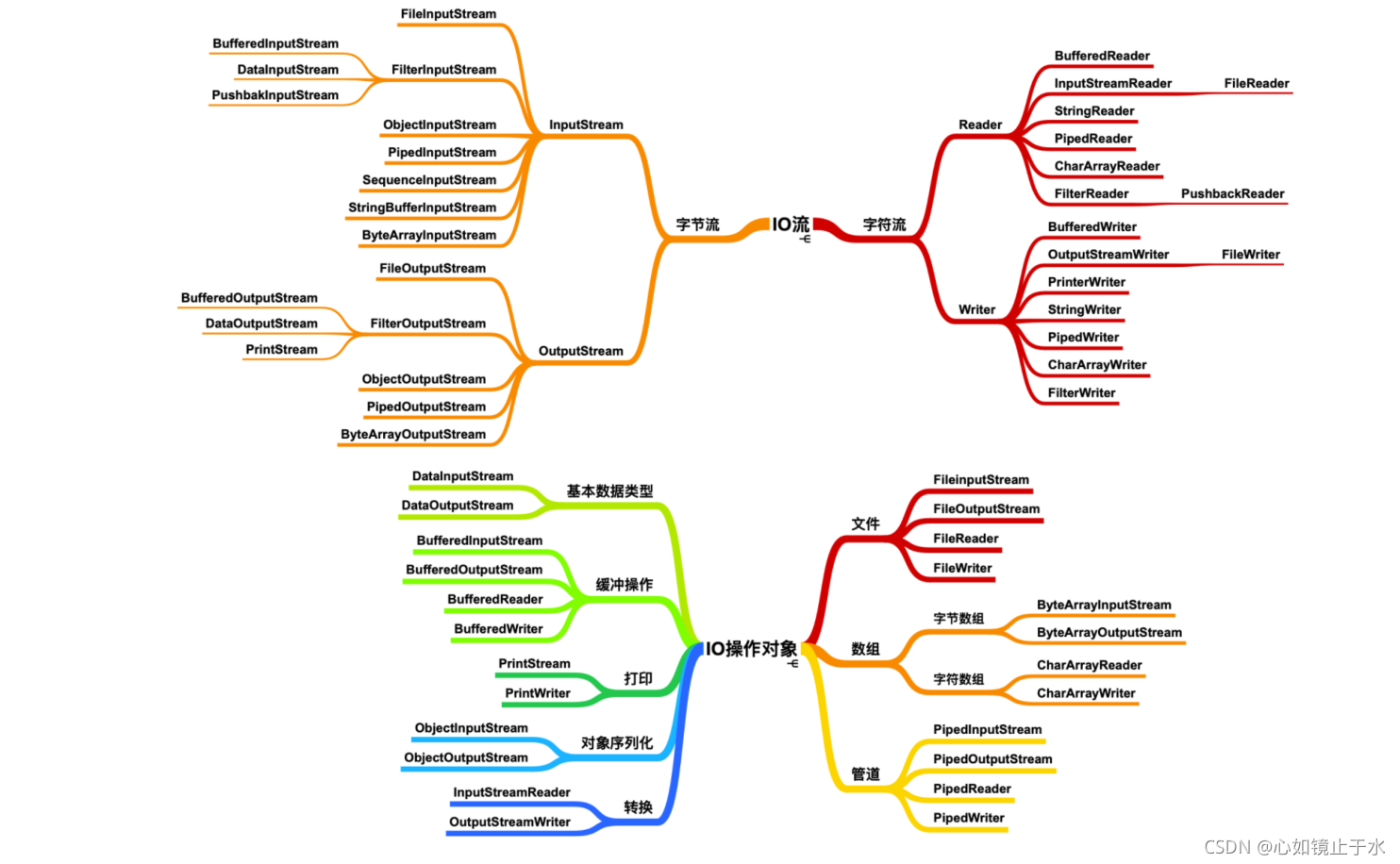I/O
File类
- 文件创建操作如下,主要涉及文件创建,删除文件,获取文件描述符等
- 如何创建File类的实例
File(String filePath)
File(String parentPath,String childPath)
File(File parentFile,String childPath) - 创建删除操作
public boolean createNewFile() :创建文件。若文件存在,则不创建,返回false
public boolean mkdir() :创建文件目录。如果此文件目录存在,就不创建了。如果此文件目录的上层目录不存在,也不创建。
public boolean mkdirs() :创建文件目录。如果此文件目录存在,就不创建了。如果上层文件目录不存在,一并创建
public boolean delete():删除文件或者文件夹
删除注意事项:Java中的删除不走回收站。
@Test
public void test1(){
//构造器1
File file1 = new File("hello.txt"); // 相对路径,相对于当前module
File file2 = new File("D:\\hello.txt"); // 绝对路径
System.out.println(file1);
System.out.println(file2);
//构造器2:
File file3 = new File("D:\\workspace","JavaSenior");
System.out.println(file3);
//构造器3:
File file4 = new File(file3,"hi.txt");
System.out.println(file4);
// 创建文件夹,mkdir不能递归创建文件夹
boolean mkdir = file3.mkdir();
if(mkdir){
System.out.println("创建成功1");
}
// mkdirs可以递归创建文件夹
boolean mkdir1 = file3.mkdirs();
if(mkdir1){
System.out.println("创建成功2");
}
// 创建文件、删除文件
if(!file4.exists()){
//文件的创建
file4.createNewFile();
System.out.println("创建成功");
}else{//文件存在
file4.delete();
System.out.println("删除成功");
}
}
- 文件夹遍历操作
public String[] list() :获取指定目录下的所有文件或者文件目录的名称数组
public File[] listFiles() :获取指定目录下的所有文件或者文件目录的File数组
@Test
public void test3(){
File file = new File("D:\\workspace_idea1\\JavaSenior");
String[] list = file.list();
for(String s : list){
System.out.println(s);
}
System.out.println();
File[] files = file.listFiles();
for(File f : files){
System.out.println(f);
}
}
- 文件的重命名
public boolean renameTo(File dest):把文件重命名为指定的文件路径,也可以用于移动文件
@Test
public void test4(){
File file1 = new File("hello.txt");
File file2 = new File("D:\\hi.txt");
// 要想保证返回true,需要file1在硬盘中是存在的,且file2不能在硬盘中存在。
boolean renameTo = file1.renameTo(file2);
System.out.println(renameTo);
}
- File类常用方法
| 方法 | 描述 |
|---|---|
| public String getAbsolutePath() | 获取绝对路径 |
| public String getPath() | 获取路径 |
| public String getName() | 获取名称 |
| public String getParent() | 获取上层文件目录路径。若无,返回null |
| public long length() | 获取文件长度(即:字节数)。不能获取目录的长度 |
| public long lastModified() | 获取最后一次的修改时间,毫秒值 |
| public boolean isDirectory() | 判断是否是文件目录 |
| public boolean isFile() | 判断是否是文件 |
| public boolean exists() | 判断是否存在 |
| public boolean canRead() | 判断是否可读 |
| public boolean canWrite() | 判断是否可写 |
| public boolean isHidden() | 判断是否隐藏 |
- File类的两个常量
File.pathSeparator //路径分隔符(于系统有关的)<windows里面是; linux里面是 :>
File.separator //与系统有关的路径名称分隔符<windows里面是 \ linux里面是/>
IO类与相关方法
一、流的分类:
- 操作数据单位:字节流、字符流
- 数据的流向:输入流、输出流
- 流的角色:节点流、处理流
二、流的体系结构
| 抽象基类 | 节点流(或文件流) | 缓冲流(处理流的一种) |
|---|---|---|
| InputStream | FileInputStream (read(byte[] buffer)) | BufferedInputStream (read(byte[] buffer)) |
| OutputStream | FileOutputStream (write(byte[] buffer,0,len) | BufferedOutputStream (write(byte[] buffer,0,len) / flush() |
| Reader | FileReader (read(char[] cbuf)) | BufferedReader (read(char[] cbuf) / readLine()) |
| Writer | FileWriter (write(char[] cbuf,0,len) | BufferedWriter (write(char[] cbuf,0,len) / flush() |
三、类之间的分类

节点流(文件流)
- 对于文本文件(.txt,.java,.c,.cpp),使用字符流处理
- 对于非文本文件(.jpg,.mp3,.mp4,.avi,.doc,.ppt,…),使用字节流处理
字符流处理
- 读字符文件
@Test
public void testFileReader1() {
FileReader fr = null;
try {
//1.File类的实例化
File file = new File("hello.txt");
//2.FileReader流的实例化
fr = new FileReader(file);
//3.读入的操作
//read(char[] cbuf):返回每次读入cbuf数组中的字符的个数。如果达到文件末尾,返回-1
char[] cbuf = new char[1024];
int len;
while((len = fr.read(cbuf)) != -1){
//方式一:
//正确的写法
//for(int i = 0;i < len;i++){
// System.out.print(cbuf[i]);
//}
//正确的写法
String str = new String(cbuf,0,len);
System.out.print(str);
}
} catch (IOException e) {
e.printStackTrace();
} finally {
if(fr != null){
//4.资源的关闭
try {
fr.close();
} catch (IOException e) {
e.printStackTrace();
}
}
}
}
- 写文件
- 输出操作,对应的File可以不存在的。并不会报异常
- File对应的硬盘中的文件如果不存在,在输出的过程中,会自动创建此文件。
File对应的硬盘中的文件如果存在:
如果流使用的构造器是:FileWriter(file,false) / FileWriter(file):对原有文件的覆盖
如果流使用的构造器是:FileWriter(file,true):不会对原有文件覆盖,而是在原有文件基础上追加内容
@Test
public void testFileWriter() {
FileWriter fw = null;
try {
//1.提供File类的对象,指明写出到的文件
File file = new File("hello1.txt");
//2.提供FileWriter的对象,用于数据的写出
fw = new FileWriter(file,false);
//3.写出的操作
fw.write("wo hahahaha!\n");
fw.write("you hahahahaha!");
} catch (IOException e) {
e.printStackTrace();
} finally {
//4.流资源的关闭
if(fw != null){
try {
fw.close();
} catch (IOException e) {
e.printStackTrace();
}
}
}
}
通过字节流复制文件
- 可以通过FileInputStream与FileOutputStream完成任意文件复制
注:FileInputStream与FileOutputStream可以完成任意文件复制,但是FileReader与FileWriter只能完成字符流文件复制
public void copyFile(String srcPath,String destPath){
FileInputStream fis = null;
FileOutputStream fos = null;
try {
File srcFile = new File(srcPath);
File destFile = new File(destPath);
fis = new FileInputStream(srcFile);
fos = new FileOutputStream(destFile);
//复制的过程
byte[] buffer = new byte[1024];
int len;
while((len = fis.read(buffer)) != -1){
fos.write(buffer,0,len);
}
} catch (IOException e) {
e.printStackTrace();
} finally {
if(fos != null){
//
try {
fos.close();
} catch (IOException e) {
e.printStackTrace();
}
}
if(fis != null){
try {
fis.close();
} catch (IOException e) {
e.printStackTrace();
}
}
}
}
处理流
缓冲流
- 缓冲流:
BufferedInputStream
BufferedOutputStream
BufferedReader
BufferedWriter - 作用:提供流的读取、写入的速度。提高读写速度的原因:内部提供了一个缓冲区
- 处理流,就是“套接”在已有的流的基础上。
- BufferedInputStream与BufferedOutputStream实现文件复制的方法
//实现文件复制的方法
public void copyFileWithBuffered(String srcPath,String destPath){
BufferedInputStream bis = null;
BufferedOutputStream bos = null;
try {
//1.造文件
File srcFile = new File(srcPath);
File destFile = new File(destPath);
//2.造流
//2.1 造节点流
FileInputStream fis = new FileInputStream((srcFile));
FileOutputStream fos = new FileOutputStream(destFile);
//2.2 造缓冲流
bis = new BufferedInputStream(fis);
bos = new BufferedOutputStream(fos);
//3.复制的细节:读取、写入
byte[] buffer = new byte[1024];
int len;
while((len = bis.read(buffer)) != -1){
bos.write(buffer,0,len);
}
} catch (IOException e) {
e.printStackTrace();
} finally {
//4.资源关闭
//要求:先关闭外层的流,再关闭内层的流
if(bos != null){
try {
bos.close();
} catch (IOException e) {
e.printStackTrace();
}
}
if(bis != null){
try {
bis.close();
} catch (IOException e) {
e.printStackTrace();
}
}
//说明:关闭外层流的同时,内层流也会自动的进行关闭。关于内层流的关闭,我们可以省略.
//fos.close();
//fis.close();
}
}
- 使用BufferedReader和BufferedWriter实现文本文件的复制
@Test
public void testBufferedReaderBufferedWriter(){
BufferedReader br = null;
BufferedWriter bw = null;
try {
//一次性创建文件和相应的流
br = new BufferedReader(new FileReader(new File("dbcp.txt")));
bw = new BufferedWriter(new FileWriter(new File("dbcp1.txt")));
//读写操作
//方式一:使用char[]数组
// char[] cbuf = new char[1024];
// int len;
// while((len = br.read(cbuf)) != -1){
// bw.write(cbuf,0,len);
// bw.flush();
// }
//方式二:使用String
String data;
while((data = br.readLine()) != null){
bw.write(data + "\n");//data中不包含换行符
}
} catch (IOException e) {
e.printStackTrace();
} finally {
//关闭资源
if(bw != null){
try {
bw.close();
} catch (IOException e) {
e.printStackTrace();
}
}
if(br != null){
try {
br.close();
} catch (IOException e) {
e.printStackTrace();
}
}
}
}
转换流
- 转换流:属于字符流
InputStreamReader:将一个字节的输入流转换为字符的输入流
OutputStreamWriter:将一个字符的输出流转换为字节的输出流 - 作用:提供字节流与字符流之间的转换
- 解码:字节、字节数组 —>字符数组、字符串
编码:字符数组、字符串 —> 字节、字节数组
- 实现编码集的转换
@Test
public void test2() throws Exception {
//1.造文件、造流
File file1 = new File("dbcp.txt");
File file2 = new File("dbcp_gbk.txt");
FileInputStream fis = new FileInputStream(file1);
FileOutputStream fos = new FileOutputStream(file2);
// InputStreamReader isr = new InputStreamReader(fis);//使用系统默认的字符集
InputStreamReader isr = new InputStreamReader(fis,"utf-8");
OutputStreamWriter osw = new OutputStreamWriter(fos,"gbk");
//2.读写过程
char[] cbuf = new char[20];
int len;
while((len = isr.read(cbuf)) != -1){
osw.write(cbuf,0,len);
}
//3.关闭资源
isr.close();
osw.close();
}





 本文详细介绍了Java中的I/O操作,包括File类的使用,如创建、删除、重命名文件和目录遍历。接着,讨论了Java I/O流的分类,如字节流、字符流,以及输入流、输出流、节点流和处理流的概念。文中还讲解了字符流的读写操作,字节流的文件复制方法,并重点阐述了缓冲流和转换流的作用,以及它们在提高读写效率和进行编码集转换中的应用。
本文详细介绍了Java中的I/O操作,包括File类的使用,如创建、删除、重命名文件和目录遍历。接着,讨论了Java I/O流的分类,如字节流、字符流,以及输入流、输出流、节点流和处理流的概念。文中还讲解了字符流的读写操作,字节流的文件复制方法,并重点阐述了缓冲流和转换流的作用,以及它们在提高读写效率和进行编码集转换中的应用。
















 427
427

 被折叠的 条评论
为什么被折叠?
被折叠的 条评论
为什么被折叠?








